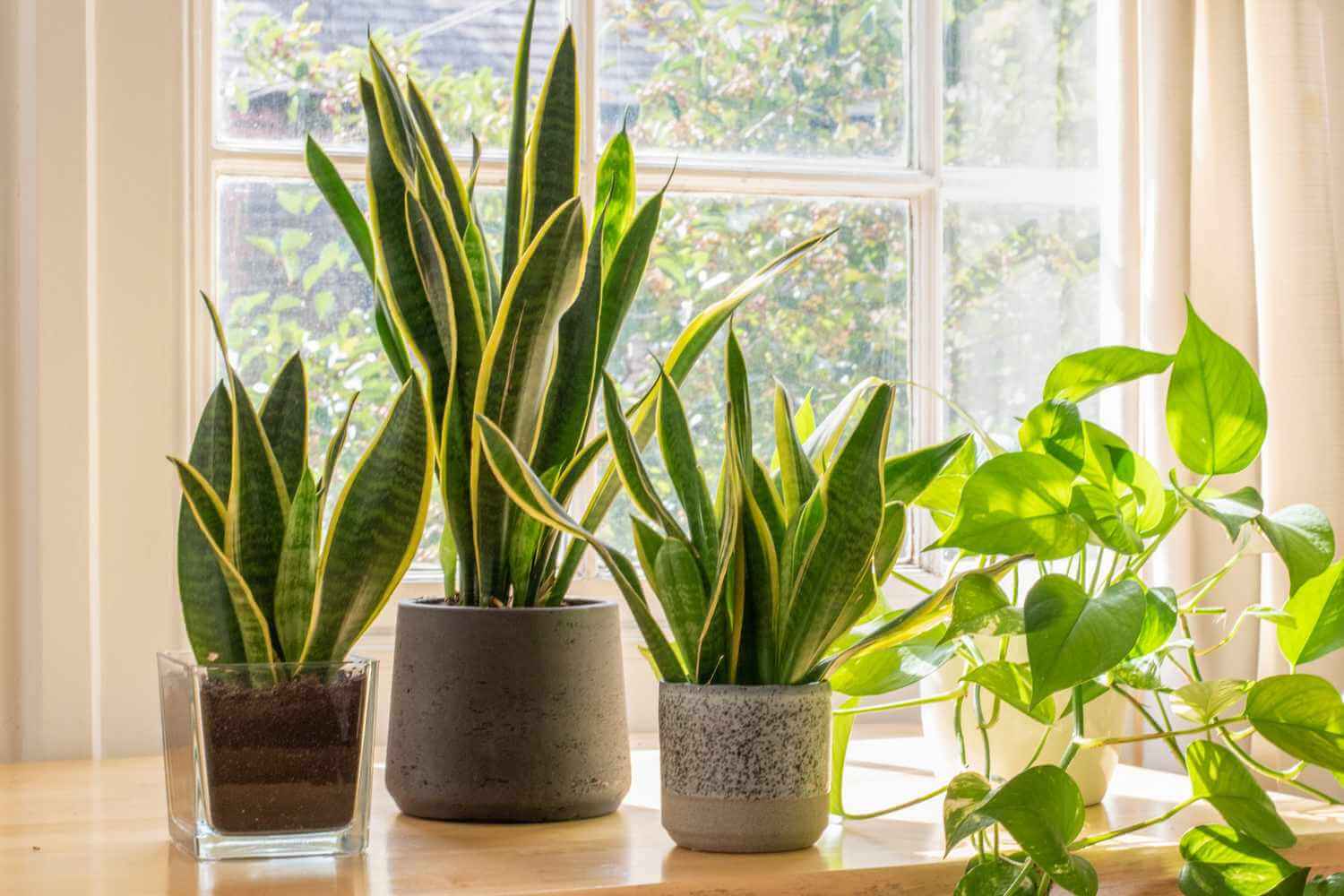
Snake plant, also known as mother-in-law’s tongue, remains a sought-after and resilient houseplant, boasting stiff, sword-like leaves. With various varieties available, many feature green-banded or striped leaves accented by a yellow or cream border.
This visually appealing and low-maintenance houseplant thrives in diverse growing conditions, making it an ideal choice for beginners and seasoned plant enthusiasts alike. Whether adorning office spaces or enhancing indoor environments, the snake plant effortlessly adds decorative flair to any setting.
Snake Plant Care
Light
Snake plants flourish with 8 to 10 hours of indirect sunlight or a few hours of early-morning direct sunlight. However, excessive sunlight exposure can lead to leaf burn, necessitating a balance to maintain optimal growth and coloration.
Soil
Optimal soil conditions for snake plants entail a loose, well-drained potting mix, preferably sandier in texture to promote healthy root development. Avoid soil mixes high in peat content, which can retain excessive moisture and compromise plant health.
Water
Watering snake plants should be done judiciously, allowing the soil to dry out completely between waterings. During winter months, reduce watering frequency to prevent waterlogged conditions that can lead to root rot.
Temperature and Humidity
Maintaining temperatures between 70°F and 90°F fosters optimal growth for snake plants, while ensuring protection from cold drafts and frost exposure. Moderate household humidity levels ranging from 30 to 50 percent suffice for healthy plant development.
Fertilizer
Periodic fertilization with a balanced, slow-release fertilizer diluted to half strength supports snake plant growth and vitality. Apply fertilizer sparingly in spring and mid-summer, abstaining from fertilization during winter dormancy.
Types Snake Plant
Explore diverse snake plant cultivars to diversify your indoor plant collection:
- Dracaena trifasciata ‘Hahnii’: Known as the bird’s nest snake plant, ‘Hahnii’ exhibits a compact growth habit, reaching a height of six inches.
- Dracaena angolensi: This cylindrical snake plant features round, stiff leaves that arch outward from a central crown, attaining several feet in length.
- Dracaena trifasciata ‘Laurentii’: Characterized by variegated creamy yellow leaf margins, ‘Laurentii’ adds a touch of elegance to any indoor space.
- Dracaena trifasciata ‘Twisted Sister’: Notable for its twisted leaves adorned with horizontal stripes and yellow variegated edges, ‘Twisted Sister’ grows up to 15 inches tall.
- Dracaena trifasciata ‘Bantel’s Sensation’: Featuring narrow leaves with white vertical stripes, ‘Bantel’s Sensation’ stands tall at three feet, adding visual interest to interiors.
- Dracaena pearsonii: Also referred to as rhino grass, this variety boasts succulent red-tinted leaves and a compact stature, reaching a height of 12 inches.
How to Propagate a Snake Plant
Propagation by Division
Spring or summer serves as the optimal time for propagating snake plants through division. Follow these steps for successful propagation:
- Utilize a sharp, clean knife to divide the plant into sections, ensuring each section retains its root structure.
- Replant divided sections in clean pots filled with well-drained potting soil, and place in a partly sunny location for optimal growth.
Propagation from Leaf Cuttings
Alternatively, propagate snake plants from leaf cuttings by following these steps:
- Use a sterile cutting tool to remove a healthy leaf at its base.
- Submerge the cut end of the leaf in water or allow it to callous over before planting in cactus potting mix.
- Monitor root development and transfer cuttings to individual pots once roots reach sufficient length.
Pruning:
Regular pruning during the growing season promotes new growth and maintains plant health. Remove damaged or overgrown leaves to encourage vitality and maintain aesthetic appeal.
Dusting Your Snake Plant
Regularly dust snake plant leaves to ensure unimpeded sunlight absorption and photosynthesis. Use a microfiber cloth to gently wipe both the front and back of each leaf spear.
Potting and Repotting
Repot snake plants every three to five years to accommodate root growth and maintain plant vigor. Select wide, shallow pots with ample drainage holes to prevent waterlogging and promote healthy root development.
How to Get Snake Plant to Bloom
While snake plants rarely bloom indoors, providing sufficient sunlight and allowing the plant to become rootbound can encourage flowering. Night-blooming flowers may emerge under ideal growing conditions, adding a touch of fragrance and elegance to indoor spaces.
Overwintering
Protect snake plants from temperatures below 50°F during winter months, bringing them indoors to ensure continued growth and vitality. Reduce watering frequency as plants enter dormancy to prevent waterlogged conditions.
Common Pests and Problems
Snake plants are susceptible to common houseplant pests such as scales, spider mites, and aphids. Address pest infestations promptly using appropriate treatments to maintain plant health and vigor. Common problems such as overwatering and root rot can be avoided by adhering to proper watering practices and providing adequate light and ventilation.
Benefits of Snake Plants
Owning a snake plant offers numerous benefits, including ease of care, adaptability to various light conditions, and compact growth habits ideal for small spaces. Additionally, snake plants contribute to indoor air quality by removing harmful toxins and purifying the air, promoting a healthier living environment.
Snake plants derive their name from their long, slender leaves, which resemble certain snake species.
Snake plants are slow growers, with growth rates influenced by seasonal changes and environmental conditions.
On average, snake plants live for five to ten years, although they can thrive for decades under optimal growing conditions.
While both are commonly referred to as snake plants, Nassauvia serpens and Dracaena trifasciata are unrelated plant species, each with distinct characteristics and growing requirements.
Snake plants can reach heights of up to three feet when grown indoors, making them suitable for various indoor environments and decor styles.